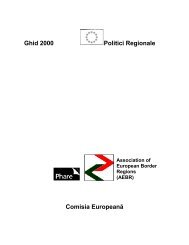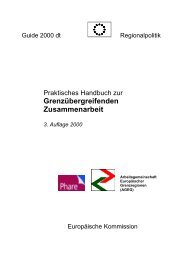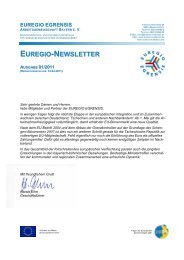GREEN PAPER - Association of European Border Regions
GREEN PAPER - Association of European Border Regions
GREEN PAPER - Association of European Border Regions
Create successful ePaper yourself
Turn your PDF publications into a flip-book with our unique Google optimized e-Paper software.
6. Conclusions<br />
6.1 Current TEN-T policy – border areas at a disadvantage<br />
26 <strong>of</strong> 30 priority projects <strong>of</strong> the TEN-T policy affect border and cross-border<br />
areas.<br />
Practically in all projects finished up to now the investments on the border were<br />
made at the very end.<br />
Practically in all projects currently being planned or under construction the crossborder<br />
sections will be finished at last.<br />
Major international infrastructure projects are merely built first in the centres<br />
/ agglomerations – if they have got their transport corridors, these centres are not<br />
any more interested what is going on elsewhere.<br />
6.2 Closing cross-border missing links in the future first<br />
As a consequence international / cross-border infrastructure projects have to be<br />
constructed first across the border:<br />
o That will cause pressure on national governments to close the gaps<br />
between the border and the centres<br />
o That will maintain the political support <strong>of</strong> centres / agglomerations for<br />
the total <strong>of</strong> the infrastructural measure<br />
<strong>Border</strong> / cross-border infrastructure could also be pre-financed by private (e.g.<br />
Chambers <strong>of</strong> Commerce representing highly interested enterprises) or regional<br />
money from both sides <strong>of</strong> the border.<br />
6.3 What can be done by the EU in practice?<br />
To give priority to border crossing infrastructural measures<br />
To implement political decisions in the transport sector in favour <strong>of</strong> border<br />
regions<br />
Liable financial concepts in favour <strong>of</strong> cross-border infrastructure (not only<br />
INTERREG)<br />
The coordination <strong>of</strong> EU-subsidies and financial instruments as a prerequisite to<br />
achieve the political modal shift, which transport policy is striking for<br />
Urgent requests for traffic concepts within border / cross-border regions. They<br />
have to be optimised in such a way as to make them economically, socially and<br />
environmentally viable in the long term (due to the huge increase in transport flows<br />
affecting especially border regions)<br />
Solve the problem <strong>of</strong> different transport systems which are not geared to the<br />
requirements <strong>of</strong> the cross-border internal market<br />
Support through intermodal transport (Marco Polo Program)<br />
Linking together border regions trough networks (roads, railways, airports,<br />
navigable water ways, highways on the seas)<br />
Better rail, road and waterway links between the main ports and the transport<br />
networks in the hinterland<br />
Plans for an intelligent management <strong>of</strong> traffic on major roads crossing the<br />
border<br />
7<br />
AGEG/AEBR/ARFE / Enscheder Str. 362 / D-48599 Gronau / Tel.: 0049 2562 70219 / Fax: 0049 2562 70259<br />
info@aebr.eu / www.aebr.eu








